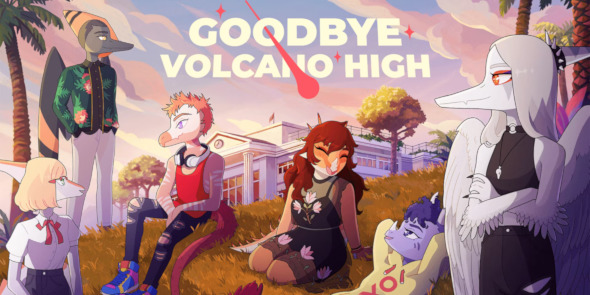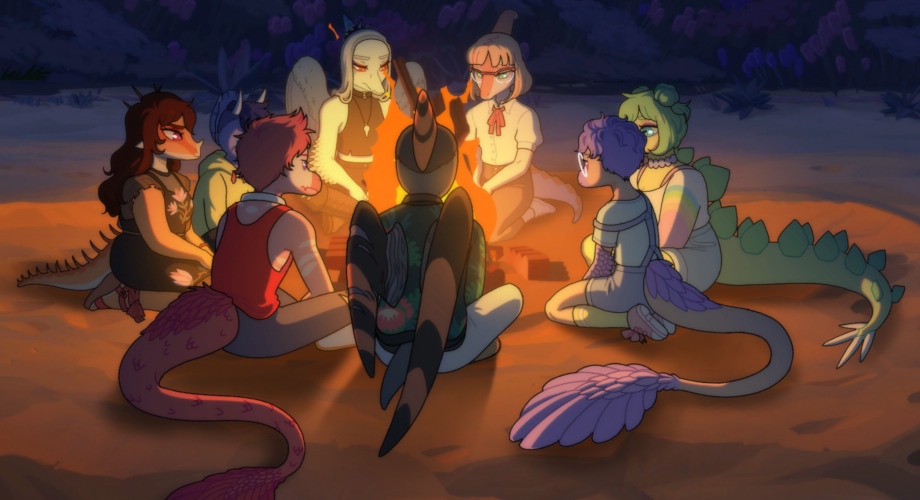'Goodbye Volcano High' - a visual novel that behaves like a slice-of-life high school anime, with dinosaurs
 Goodbye Volcano High is a visual novel game developed by KO_OP. You play a high school senior, Fang, as they [nonbinary] use their last moments working with schoolmates to bring their band, Worm Drama, to success. Fang is a pterodactyl whose school exists in a place called Pangea.
Goodbye Volcano High is a visual novel game developed by KO_OP. You play a high school senior, Fang, as they [nonbinary] use their last moments working with schoolmates to bring their band, Worm Drama, to success. Fang is a pterodactyl whose school exists in a place called Pangea.
The universe and Fang’s friends may have other plans to cause a hiccup in the dream they wish to fulfil. I’d call this a spoiler, but the advertising and title make it clear that this is a prequel to Dino Run. I mean, the logo has a meteor and its characters are dinosaurs. That can’t end well.
This is a very interesting premise, and makes for a good background to make this high school drama stand out from its contemporaries. However, the narrative comes out a bit flatter than expected, focusing more on the day-to-day issues of Fang than the cataclysm to come. In turn, there’s passion in the music, artistic design, and characters that many furries will find interest in. Let’s go through some of these to see if it’s the right game for you.
Good production values and art direction
I’ll start off with the aspects I liked about the game and that would be its production value when it comes to the art and music. For a visual novel it felt a bit more closer to an interactive anime than what the genre is mostly known for – static images acting as puppets to emote particular scenes.
The settings also have variety, as they all have their own artistic charms: from the plants on the school’s roof, to characters interacting in a car while showing things in motion, and then interacting with items such as radio knobs. The places feel like actual places, with multiple rooms and layouts – each having their spaces filled out and feeling alive instead of just being a static picture.
You have to make decisions very frequently; however, the ways they impact the actual story can be hard to perceive. They do influence which character you’ll eventually get to have more personal conversations with. Therefore there’s missable content that encourages repeated playthroughs.
The character designs are nice, and their designs are memorable. They each have their own hobbies and interests. But their names are a whole other story; aside from Fang, they’re pretty normal names, and without the avatar present you may forget who is who if you have trouble with the whole name-to-face thing. Though that may be more a skill issue on my part. Speaking of skill: there are music minigames you play at times throughout the game. These are not challenging but are a good break from the main story itself. The songs are also decently composed to give off an indie band vibe.
Some choices you make in dialog also require additional button presses and quick-time-esque interaction for if your character has to overcome self doubts or anxieties to say things. I thought these were interesting, but the button press combinations didn’t seem to have enough variety. Eventually I’d be able to choose the tough options just as easily as the normal ones once my understanding of the mechanic took hold.
A setting and story that didn’t vibe with the reviewer
It’s at this time I have to make a confession – I don’t care for the high school setting as a story element. Particularly a modern high school. Statistically, furries are the most likely people to experience bullying from their peers in their school, and I was no exception to that rule. In addition, if the setting is themed around being so similar to the world in its current state, then I’d probably find more use in getting out of the game and interacting with the actual world than playing a simulation of it.
I’d probably find such a game more useful if I were a high schooler myself, so perhaps a more teenage audience can find value in a story like this. However, as a more experienced adult, you can pick up on nuances of the character’s wishes and desires more quickly than the protagonist you play. This can lead to moments where you can feel frustrated – because you, if you were in their shoes, would have gotten ahead of the drama, whereas the protagonist lets it wait until it causes more problems.
Then, when you think that Fang has learned the lesson about letting go and allowing their friends to have more agency rather than being pawns towards their own dreams, Fang kind of gets what they want in the end without that need to compromise. So from a narrative sense, I found no value from it. It was a slice of life that didn’t leave as much of an impact as the smaller and leaner Lookouts did. And Lookouts didn’t have a meteor in it.

Bigger is not always better when it comes to content created, and I think that playing Lookouts right next to Goodbye Volcano High did much to highlight this for me. The team for the western visual novel fit on one screen, where the team for Volcano High was quite sizable. However if you were to quiz me on the story beats a few years from now, Lookouts would stick with me more than Goodbye.
Again, this could be a personal preference thing. The writing itself was good, and the characters and situations are nice. But the themes, genre, and conclusion based on the theming didn’t resonate with me. I think it's well worth the play if you’re a person who gets nostalgic for those simpler times of hanging out with friends and taking classes. If you’d rather not be reminded about those times in your life, it may be worth a (hall) pass. After all, you can start a band or roleplaying game sessions with your peers no matter your age, so get out there and do it.

About the author
Sonious (Tantroo McNally) — read stories — contact (login required)a project coordinator and Kangaroo from CheektRoowaga, NY, interested in video games, current events, politics, writing and finance
Comments
I recall this game being hyped up rather significantly at the time. Perhaps it's not surprising that, while it seems a good enough example of the genre - even very good for some - it isn't the be-all and end-all to everyone.
As someone who has never played a visual novel before, I absolutely loved it.
On a technical level, it's pretty advanced for a 'visual novel' to the point where most people may not even call it one. In fact the genre Google gave it was 'Rhythm game' due to the band play moments. But that's not the majority of gameplay by far.
But I'm strange in how I define a 'visual novel', which is typically:
1) Story stands on its writing and could be easily translated into a book if the visual elements were translated into text.
2) Reading [voice acted or not] is the vast majority of gameplay (80%+).
Traditionally visual novels on a graphic level are more static and paper puppet like where you usually are the main character (1st person) looking at static images talking to you. The fact that they did more with it than that is very impressive, and quite rare.
It's kind of a percentage thing for me. For instance, I kind of consider Night in the Woods a visual novel that has heavy platforming elements. So it's a hybrid genre. Ironically, Night in the Woods also had band rhythm games sprinkled within.
Post new comment